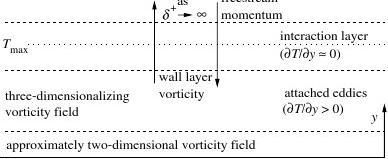《Balance》观后感
这是个微妙的平衡……
当一个人把音乐盒钓上来的时候,当一个人取得成功的时候,他身后有许多人来帮助他维持这个平衡。这就是团队,这个钓者他身后是一个团队,代表的是人与人之间的合作意识。团队的成员共同维系着木板的平衡,并在此基础上为自己谋福利。所以他们试图破坏平衡,让箱子滑向自己。影片的最后,“胜利者”成为最大的“失败者”,他将四个同伴驱逐,自己却只能与音乐盒分离在木板的两头。可望不可即。而五个人之间的平衡,却永远不能再恢复。死亡和遥不可及是他们最终付出了代价。影片中红色的音乐盒,它为这个枯燥的空间增添了一丝色彩。但它改变着人们的情绪,破坏着原有的平衡。利益是打破平衡的罪魁祸首,而自私和贪欲使得最后利益无法被人占有,还失去了平衡。
一个政治立场坚定,团结协作,以身作则的团队对于我们的进步起着重要的作用。一个团队如何在利益面前人人平等,如何实现“双赢”是值得我们深思的。
第四团队 领袖队
自动化12-3班
孟元
第二篇:balance
Phil.Trans.R.Soc.A(2007)365,823–839
doi:10.1098/rsta.2006.1944
Publishedonline16January2007
Aphysicalmodeloftheturbulentboundary
layerconsonantwithmeanmomentum
balancestructure
BYJOEKLEWICKI1,*,PAULFIFE2,TIEWEI3
1ANDPATMCMURTRY4DepartmentofMechanicalEngineering,UniversityofNewHampshire,
Durham,NH03824,USA2DepartmentofMathematics,and4DepartmentofMechanicalEngineering,
UniversityofUtah,SaltLakeCity,UT84112,USA3DepartmentofMechanicalandNuclearEngineering,PennsylvaniaState
University,StateCollege,PA16802,USA
RecentstudiesbythepresentauthorshaveempiricallyandanalyticallyexploredthepropertiesandscalingbehavioursoftheReynoldsaveragedmomentumequationasappliedtowall-bounded?ows.Theresultsfromtheseeffortshaveyieldednewperspectivesregardingmean?owstructureanddynamics,andthusprovideacontextfordescribing?owphysics.Aphysicalmodeloftheturbulentboundarylayerisconstructedsuchthatitisconsonantwiththedynamicalstructureofthemeanmomentumbalance,whileembracingindependentexperimentalresultsrelating,forexample,tothestatisticalpropertiesofthevorticity?eldandthecoherentmotionsknowntoexist.Forcomparison,theprevalent,well-established,physicalmodeloftheboundarylayerisbrie?yreviewed.Thedifferencesandsimilaritiesbetweenthepresentandtheestablishedmodelsareclari?edandtheirimplicationsdiscussed.
Keywords:wall-turbulence;scaling;?owphysics;meanmomentumbalance
1.Introduction
Fluiddynamicboundarylayersformin?owstangentialtoano-slipwall.Afoundationalnotionpertainingtotheboundarylayeristhatthereisalwaysaregionnearano-slipsurfacewithinwhichthedirecteffectsofviscosityaredynamicallysigni?cant(Prandtl1904;Schlichting1979).WithincreasingReynoldsnumber,thisregionnecessarilybecomesadecreasingfractionoftheoverall?owdomain.Inthismanner,thesolutiontotheNavier–StokesequationapproachesthatoftheEulerequationastheReynoldsnumberbecomeslarge(e.g.alimitingmodelfortheboundarylayerisavortexsheetpositionedin?nitesimallyabovethewall).Giventhis,acentralobjectiveofboundarylayertheoryistodeterminethisrateatwhichtheeffectsofviscositybecomespatially

localized.
*Authorforcorrespondence(joe.klewicki@unh.edu).
Onecontributionof14toaThemeIssue‘ScalingandstructureinhighReynoldsnumberwall-bounded?ows’.
823Thisjournalisq2007TheRoyalSociety
824J.Klewickietal.
Inconnectiontodynamics,attainingthisobjectivealsoservestorevealthescalingbehaviourofthemomentum?eld,sincedoingsoeffectivelydeterminesthenormalizationrequiredtowritethemomentumbalanceequationinaformthatremainsinvariantforvaryingReynoldsnumber.Perhaps,themostfamousexampleofthispertainstothe?atplatelaminarboundarylayer,asthewell-?p?????established1=Rxscalingbehaviourdirectlyre?ectstherateatwhichviscouseffectsdiminish(spatiallylocalize)withincreasingReynoldsnumber.Asmightbeexpected,identifyingthedominanttermsinthemomentumbalancealongwiththosenormalizationsthatretainthisbalanceindependentofReynoldsnumber(i.e.theReynoldsnumberp??????scalings)alsoprovidesabasisforeducing?owphysics.Forexample,the1=Rxbehaviourisalsodirectlyassociatedwiththedynamicsrealizedviathecompetitionbetweentheadvectionandthewall-normaldiffusionofaxialmomentum.
Ofcourse,determiningthescalingbehavioursassociatedwiththemeanmomentum?elddevelopmentinsmooth-wallturbulentboundarylayersisconsiderablymorechallenging.Primaryreasonsforthisarethat(i)themeanmomentumequationisindeterminateowingtotheappearanceoftheReynoldsstressesand(ii)insometurbulentwall-?ows,therearesubregionswithinwhichviscouseffectsarenegligibleinthemean.Thesechallengesnotwithstanding,signi?cantprogresshasrecentlybeenmadetowardsidentifyingtheappropriateapproximateformsofthemeanmomentumbalance(MMB)asthelayeristraversed,aswellasinidentifyingthosenormalizationsthatrenderthesesimpli?edformsoftheequationinvariantwithvariationsinReynoldsnumber(Fifeetal.2005a,b;Weietal.2005a).
TheprimarypurposesofthecurrenteffortaretopresentaphysicalmodeloftheturbulentboundarylayerthatisconsistentwiththestructureoftheMMBandtocompareitwiththeestablishedprevalentmodel.
2.Theprevalentphysicalmodel
Forthepurposeofcomparison,thissectionprovidesarelativelybriefdiscussionofthepredominant,well-accepted,modeloftheturbulentboundarylayer.
(a)Meanpro?le-basedlayerstructureandscalingbehaviours
Theprevalentphysicalmodelofthemeanstructureofthesmooth-wallturbulentboundarylayerhasratherdirectconnectiontothepropertiesofthemeanvelocitypro?le(e.g.Tennekes&Lumley1972;Pope2000;Davidson2004).(Herein,xistheaxialcoordinate,yisthewallnormalcoordinate,UandVarethevelocitycomponentsinthex-andy-directions,respectively,uppercaselettersrepresentmeanquantities,lowercaselettersdenote?uctuating
~ZUCu),anoverbarquantities,tildedenotesinstantaneousquantities(i.e.u
denotestimeaveragingandvorticitycomponentsareidenti?edbytheirsubscript.)Figure1ashowsrepresentativeturbulentboundary-layermeanvelocitypro?les.Thesepro?lesphave??????????beenmadenon-dimensionalusinginner
??w=risthefrictionvelocity,twisthewallshearvariables,utandn,whereutZt
stressandnisthekinematicviscosity,asdenotedbyasuperscript‘C’.Thus,aReynoldsnumberbasedonthefrictionvelocityandtheboundarylayerthickness,d,isgivenbydCZdut/n.Asisconventional,thedatain?gure1arePhil.Trans.R.Soc.A(2007)
Turbulentboundarylayermodel
(a)(b)1.0
AB0.8
0.6
0.4
C
110100
y+D10000.20.00100200300y+400500dU+/dy+<UV>+82530252015U+1050600
Figure1.Inner-normalizedmeanvelocityandstresspro?les.(a)Turbulentboundarylayermeanpro?lesandtheirassociatedlayerstructure:(A)viscoussublayer,(B)bufferlayer,(C)logarithmiclayerand(D)wakelayer(dataarefromKlewicki&Falco(1990)).(b)ViscousandReynoldsshearstresspro?lesinturbulentchannel?ow,dCZ590,whereinthiscasedisthehalfchannelheight.ThesedataarefromMoseretal.(1999).
plottedonsemi-logarithmicaxes.Themainfeaturesofthisgraphare(i)alayerimmediatelyadjacenttothesurfacewherethenormalizedpro?leislinear(A),(ii)alayerwherethedependenceofUConyCtransitionsfromlineartoapproximatelylogarithmic(B),1(iii)aregionofapproximatelylogarithmicvariation(C),followedby(iv)anextensiveouterregionwithinwhichUCvariesaccordingtoafunctionconsistingofalogarithmicpartplusawakepart,w(y/d).Dynamically,theviscoussublayer(A),0%yC%4,isidenti?edasaregionwhereviscosityhasamajoreffect.Inthebufferlayer(B),4%yC%30,theviscousandReynoldsstressesarebothdynamicallysigni?cant.Thelogarithmiclayer(C)extendsfromnearyCZ30toy/dx0.2andisseentobedominatedbytheeffectsofturbulentinertia.Withinthewakelayer(D),0.2%y/d%1,meanandturbulentinertiaarepredominant.
Attachingthesetime-averageddynamicalattributestolayersA–Distypicallyjusti?edbyexaminingtherelativemagnitudesofthemeanviscousstress,
(e.g.Tennekes&vUC/vyC,andtheReynoldsshearstress,TCeyCTZLumley1972;Pope2000;Davidson2004).Representativepro?lesofthesequantitiesareshownin?gure1b.ThesedatarevealthatthemagnitudeofTCiszeroatthewall,butrapidlyrisestoavaluethatisO(1)byyCx30.Conversely,vUC/vyCZ1.0atyCZ0,butdiminishestoaquantitythatismuchlessthanO(1)byyCx30.(Herein,theordersymbol,O($),willbeusedwithrespecttoe/0,whereeisasmallparameter,e.g.e2Z1/dC.Forexample,aZO(b)forpositivea(e)andb(e)istakentomeanthatbotha/bandb/aareboundedase/0.)Theseobservationsarecommonlyusedtosupportthenotionthat,inthemean,thedynamicaleffectsofinertiabecomegreaterthanthoseofviscositybeginninginlayerBandpredominantlysowiththeoutwarddistancefromlayerB.
ExaminationofthelayerthicknessesandthevelocityincrementsacrosstheselayersrevealstheReynoldsnumberdependenciesinherenttothisphysicalmodel.Thesedependenciesarelistedintable1.Asisapparentfromtheentries1Notethatapproximatelylogarithmicdoesnotexcludecertainpower-lawforms.Also,recentexperimentaldataprovideevidencethatthetraditionallyde?nedlogarithmiclayeriscomposedoftworegionshavinglogarithmic-likebehaviour,butnotnecessarilythesameslope(Osterlundetal.2000;McKeonetal.2004).
Phil.Trans.R.Soc.A(2007)
826J.Klewickietal.
Table1.Scalingbehavioursofthelayerthicknessesandlayervelocityincrementsassociatedwiththepredominantlyacceptedphysicallayerstructureoftheturbulentboundarylayer(C,DandEareconstants).
physicallayer
A
B
C
D(viscoussublayer)(bufferlayer)(logarithmiclayer)(wakelayer)DyincrementO(n/ut)(x4)O(n/ut)(x26)O(d)(/0.2d)O(d)(x0.8d)DUincrementO(ut)(x4)O(ut)(x9)O(UN)(x(ut/k)log(d/C))
O(UN)(x(ut/k)log(d/D)CE)
intable1,thelayersassociatedwiththedirecteffectsofviscosity(AandB)haveathicknessthatremainsa?xednumberofviscouslengthsindependentofReynoldsnumber.Correspondingly,withincreasingdC,theselayerthicknessesbecomeadiminishinglysmallfractionofdataratedirectlyproportionalto1/dC.Similarly,thevelocityincrementsacrosstheselayersaremeasuredbya?xednumberofut,andthusasdC/N,theybecomediminishinglysmallrelativetoUNatarateproportionaltout/UN.Conversely,boththelogarithmiclayerandthewakelayergrowatarateproportionaltodasdC/N.Ofcourse,whenmeasuredinviscouslengths,theselayerthicknessesareunboundedasdC/N.Inasimilarmanner,thevelocityincrementacrosseitherlayerCorDapproachesa?xedfractionofUNasdC/N.
(b)Dynamicalconsiderations
Importantelementsassociatedwiththepredominantmodelrelatetothederivationofthelogarithmicmeanvelocitypro?le.Whileotherderivationsexist,theconstructioncommonlydeemedmostrigorouspostulatestheexistenceofatwo-layermathematicalstructure(innerandouter),andassumesthattheinnerandouterscalingshaveacommonregionofoverlapwithinwhichbotharesimultaneouslyvalid(e.g.Millikan1939;Tennekes&Lumley1972;Pope2000;Panton2005).Underfurtherassumptionthatthepro?lestrictlyincreaseswithy,themeanvelocitygradient(simultaneouslyexpressedinitsinnerandouterforms)ismatchedintheoverlaplayerasyC/Nandh/0.Theclassicalformsofthelogarithmiclawofthewallanddefectlawsubsequentlyfollow.Accordingtothisdescription,theinnerlayerextendsfromthewalltotheouteredgeofthelogarithmiclayer,andtheouterlayerextendsfromtheinneredgeofthelogarithmiclayertod.Animportantphysicalimplicationofthismathematicaldescriptionisthecorrespondencebetweentheoverlaplayerandaninertialsublayer.Thus,considerableresearchhasbeendevotedtowardsunderstandinglogarithmiclayerturbulenceanditssimilaritiestothespectralversionofinertialrangeturbulence(e.g.Townsend1976;Perry&Abell1977;Perry&Marusic1995;Morrisonetal.2004;Davidsonetal.2006;McKeon&Morrison2007;Metzger2006).
Otherconsiderationspertaintohowanygivenmodelsetstheconceptualframeworkforinterpretingmeasurementsandobservations.Notableamongtheserelatetodescribingthecharacteristicsanddynamicalbehavioursofboundary-layercoherentmotions.Acomprehensivereviewofboundary-layercoherentmotionsiswellbeyondthescopeofthepresenteffort.ItisusefulhowevertoidentifyPhil.Trans.R.Soc.A(2007)
Turbulentboundarylayermodel827
theimplicationsofthepredominantmodelrelativetotheinterpretationofdynamicalprocesses.Tothisend,issuesrelatingtotheself-sustainingmechanismsandtheso-calledinner/outerinteractionarenowbrie?ydiscussed.
Assupportedbythestresspro?lesof?gure1bandothernear-wallstatisticaldata(e.g.theturbulencekineticenergypro?le),theprevalentmodelplaceshighimportanceonthenear-wallregion(bufferlayerandbelow;e.g.Robinson1990).Numerouscoherentmotionshavebeenidenti?edasdynamicallysigni?cantinthisregion—includingstreaks,pockets,streamwisevortices,internalshearlayersandhairpinvortices.Indeed,thisregionisassertedbymanytobewheretheself-sustainingmechanismsofboundarylayerturbulenceprimarilyreside(e.g.seeanumberofcontributionstoPanton1997).Itisalsogenerallyaccuratetoattributethisfocusonthenear-wallregionwiththeidenti?cationofthebufferlayeraswherethedynamicstransitionfrombeingstronglyin?uencedbyviscositytowhereturbulentinertiadominates(Pope2000;Davidson2004).Thislastnotionalsohasbearingonhowtoconstructadescriptionoftheso-calledinner/outerinteraction.Properlycharacterizingthenatureoftheinteractionsbetweentheinnerandtheouterlayersisassertedbymanytobecentraltounderstandingturbulentboundarylayerdynamics(e.g.Kline1978;Falco1983;Thomas&Bull1983;Klewicki1989;Sreenivasan1989;Wark&Nagib1991).Thisassertion?ndssupportfromatleasttwocompellingarguments.Atperhapsthemostfundamentallevel,theturbulentboundarylayermaybeconsidereda?uiddynamicalmachinethat,onanaverage,convertsfree-streammomentumintotangentialforceactingatthe?uid/solidinterface.Giventhis,oneisthenfacedwithdescribinghowthenetmomentumtransferacrossthelayeroccurs,andthustheinner/outerinteraction.Similarly,aprimarycharacteristicoftheboundarylayeristhatwithincreasingdCtheratiooftheoutertotheinnerlength-scaleincreases.Theinner/outerinteractionisunavoidablyconfrontedifthedynamicalaccommodationtothisscaleseparationistobedescribed.Apparently,owingtoitsinherentcomplexities,theinner/outerinteractionremainsresistivetoathoroughcharacterization.Forexample,iftheviscous/inertialinteractionisseenascentraltotheinner/outerinteraction,thentheprevalentmodelplacesitinthebufferlayerforalldC.Ontheotherhand,byde?nition,theoverlapregioniswhereinnerandouterscalingsaresimultaneouslyvalid,andthusjusti?cationtoprimarilyassociateinner/outerinteractionswiththelogarithmiclayer.Doingso,however,requiresexplainingwhyinner/outerinteractionsshouldoccurinaninertialsublayer,2andnotintheregionwheretheviscousandReynoldsstressesareofthesameorderofmagnitude.
Lastly,asigni?cantandgrowingbodyofresults(Wark&Nagib1991;Meinhart&Adrian1995;Adrianetal.2000;Ganapathisubramanietal.2003,2005;Tomkins&Adrian2003;Morrisetal.inpress;Priyadarshanaetal.2007)supporttheperspectivethatthelogarithmiclayerisinstantaneouslycomposedofahierarchyofmotions,andthatthesemotionsarenominallyarrangedasuniformmomentumzonessegregatedbyrelativelynarrowvortical?ssures.Atpresent,itisnotreadilyapparenthowsuchaninstantaneousstructuremightgiverisetoamathematicaldescriptionbaseduponanoverlaplayer.ThistypeofEmpiricalobservationsrelatingtothebehaviourofthelogarithmicmeanpro?lehaverecentlypromptedproposalsregardingtheexistenceofameso-layer(Wosniketal.2000)intheregion30%yC%300andanextended‘bufferregion’(Osterlundetal.2000)outtoaboutyCZ200.Phil.Trans.R.Soc.A(2007)2
828J.Klewickietal.
hierarchicalstructurehoweverwouldseemtohavearathernaturalconnectiontotheearlier,phenomenological,logpro?lederivationbaseduponpostulatingthedistancefromthewallastheappropriatelength-scale(Prandtl1925).
3.Analternativephysicalmodel
Recentempiricalobservationsandmultiscaleanalysisprovidethebasisforanalternativephysicalmodeloftheturbulentboundarylayer(Fifeetal.2005a,b;Weietal.2005a,b).Animportantpremiseunderlyingthelayerstructuretobedescribed,andinturnthealternativephysicalmodel,isthattheMMBinitsunintegratedform(andinthiscaseasappliedtoboundarylayer?owoveraplanarsurfacelocatedatyZ0),
CCv2UCvTCCvUCvUUCVZC;e3:1Tvxvyvyvy
providesthetime-averageddescriptionofthedynamics.Theleftsideofequation(3.1)representsadvectionbythemean?ow,whiletheright-sidetermsrepresenttheviscousandReynoldsstressgradients,respectively.Forthe?atplate?ow,thereareonlythesethreedistinctdynamicaleffects,andthustheratioofanytwodeterminesthenaturebywhichtheequationisbalanced.
(a)MMB-basedlayerstructureandscalingbehaviours
Weietal.(2005a)exploredthestructureofboundarylayer,pipeandchannel?owsbyexaminingtheratioofthelasttwotermsinequation(3.1).Thedynamicsre?ectedbyequation(3.1)mustarisefromabalanceofatleasttwonon-negligibleterms,andthusinterpretationofthisratioisasfollows.(i)Ifjev2UC=vyC2T=evTC=vyCTj[1,thentheReynoldsstressgradienttermisnegligibleandequation(3.1)sumstozeroessentiallythroughabalance
ofthemeanadvectionandviscousstressgradientterms.
(ii)Ifjev2UC=vyC2T=evTC=vyCTj/1,thenthemeanviscousstressgradienttermisnegligibleandequation(3.1)sumstozeroessentiallythrougha
balanceofthemeanadvectionandReynoldsstressgradientterms.
(iii)Ifjev2UC=vyC2T=evTC=vyCTjx1,thentheReynoldsstressandtheviscousstressgradientsbalanceandareeithergreaterthanorofthesameorderof
magnitudeasthemeanadvectionterm.
Availablehigh-qualityexperimentalandDNSdata(Zagarola&Smits1997;Moseretal.1999;DeGraaff&Eaton2000)weredifferentiatedandtheindicatedratiowasexaminedasafunctionofyfordifferingdC.Thesketchof?gure2depictsthebehaviourofthestressgradientratioatany?xeddC.Asindicated,thedynamicalbalanceisdescribedbyafour-layerstructure.LayerIessentiallyretainsthecharacteroftheviscoussublayer,andintheboundarylayerisaregionwheretheviscousstressgradientnominallybalancesmeanadvection.InlayerII,themagnitudeoftheratioisveryclosetounity,andthusthislayeriscalledthestressgradientbalancelayer.Acrossthemesolayer(layerIII),theReynoldsstressgradientchangessignandthetermsinequation(3.1)undergoabalancebreakingandexchange(Fifeetal.2005b;Weietal.2005a).WithinlayerIII,allthethreePhil.Trans.R.Soc.A(2007)
Turbulentboundarylayermodel
ratio of stress
gradients
peak Reynolds
stress location829
?1y+
IIIIIIIV
Figure2.SketchoftheratiooftheviscousstressgradienttotheReynoldsstressgradientinboundarylayer,pipeandchannel?owsatanygivenReynoldsnumber.ThedottedlineinlayerIisforaboundarylayer,andthesolidlineisforapipeorchannel.
Table2.Scalingbehavioursofthelayerthicknessesandvelocityincrementsoftheproposedalternativemodel.(NotethatthelayerIVpropertiesareasymptoticallyattainedasdC/N.)physicallayer
I
II
III
IVDyincrement3)O(n/ut)(x??p??????????????Ond=ut(x1.6)??p??????????????Ond=ut(x1.0)O(d)(/d)DUincrementO(ut)(x3)O(UN)(xUN/2)O(ut)(x1)O(UN)(/UN/2)termsinequation(3.1)arenominallyofthesameorderofmagnitude,3andfromtheouteredgeoflayerIIItoyZd(i.e.layerIV),equation(3.1)ischaracterizedbyabalancebetweenthemeanadvectionandtheReynoldsstressgradient.
Thefeaturesof?gure2,depictedfor?xeddC,persistforthedCrangecurrentlyaccessibletoinquiry(e.g.spatialresolutioninthePrincetonSuperpipelimitedtheReynoldsnumbertoRC%41235).Inthisregard,itisalsorelevanttonotethatboundarylayerandpipe/channel?owsexhibitthesamebehaviourstowithinthedifferencesbetweenthemeanadvectionandpressuregradientpro?les.Thus,forexample,inlayerIItheirstructureisexpectedtobehighlysimilarsinceinthislayerthesetermsaremuchsmallerthanthedominantstressgradientterms.Quantitatively,thelayerthicknessesandthevelocityincrementsacrosstheselayershavebeenshownbothempiricallyandanalyticallytoexhibitdistinctReynoldsnumberdependencies.Table2presentsthesescaling3Ofcourse,rightatthepeakintheReynoldsstresstheReynoldsstressgradientpassesthroughzero,andthusinanarrowzonearoundthispointwithinlayerIIItheReynoldsstressgradientissmallerthantheothertwoterms.
Phil.Trans.R.Soc.A(2007)
830
(a)
80
60
40
×10?3200
?20
?40
?60
?80IIIIIIJ.Klewickietal.(b)III~(d +)1/2III~(d +)1/2IVlineU +?U = 1utIV?U = U∞/2
110100log(y+)
Figure3.AttributesoflayersIIandIII:(a)innernormalizedReynoldsstressgradient(solidline)andviscousstressgradient(dashedline)pro?les(dataarefromtheRqZ1410DNSofSpalart(1988))and(b)schematicdepictionoftheconnectionbetweenthegrowthratesoflayersIIandIIIandtheirassociatedvelocityincrements.
behaviours.Asisevident,layersIandIVadheretoinnerandouterscaling,respectively.Ontheotherhand,layersIIandIIIexhibitmixedscalingproperties.TheinnernormalizedthicknessoflayerIIgrowslikethegeometricp?????CmeanoftheReynoldsnumber(i.e.wd),whileitsvelocityincrementp?????remainsaCC?xedfractionofUN,independentofd.Similarly,DIIIywdC,whileitsvelocityincrementisonlyabout1.0ut,independentofdC.Thesescalingbehavioursdifferconsiderablyfromtheprevalentmodelandareassociatedwith????????????ptheexistenceofathirdfundamentallength-scale,nd=ut.Thislengthisintermediateton/utandd,requiredtoscaletheMMBinlayerIIIandbecomesincreasinglydistinctasdC/N.
ThemeandynamicsandscalingbehavioursassociatedwithlayersIIandIIIarecentral(andapparentlyunique)totheproposedphysicalmodel,andthuswarrantfurtherdiscussion.LayerIIiscalledthestressgradientbalancelayersincethedominantdynamicalmechanismsarethetermsontherightofequation(3.1);theirratiobeingK1in?gure2.Contrarytotheprevalentnotionthat,onanaverage,boundarylayerdynamicsaredominatedbyturbulentinertiaoutsidethebufferlayer(independentofdC),momentumbalancedatarevealthatanequalcompetitionbetweentheviscousforceandtheturbulentforcepersiststoay-locationnearthepeakintheReynoldsstress,Tmax.ConsistentwiththemathematicalhierarchyofscalinglayersrevealedbyFifeetal.(2005a),inthemodelposedbelowthiscompetitionisassociated(inatime-meansense)withthevorticalmotionsformingandevolvingfromthenear-wallvorticity?eld.Itissigni?canttonote,however,thatthebalanceinlayerIIcomesaboutviatwooppositesign,nearlyequal,butdecreasingmagnitudefunctions.ThesefunctionslosedominanceovermeanadvectionaslayerIItransitionsintolayerIII(?gure3a).
Thescalingsoftable2revealthatthelayerIIandIIIthicknessesarecoupled,suchthattheirvelocityincrementsfollowouterandinnerscaling,respectively.Thesepropertiesunderlienewinterpretationsrelatingto,forexample,thenatureoftheinner/outerinteractioninboundarylayers.ItisrelevanttonotethatthemajorportionsoflayersIIandIVandalloflayerIIIresidewithintheboundsofthetraditionallyde?nedlogarithmiclayer.TheloweredgeoflayerIIis?xedneartheedgeoftheviscoussublayer(independentofdC),whilethepositionofitsPhil.Trans.R.Soc.A(2007)
Turbulentboundarylayermodel
detached eddies
(?T/?y < 0)
831fully three-dimensionalvorticity field

IVIIIII
IFigure4.Schematicofsomeofthedynamicalattributesoftheproposedmodelfortheturbulentboundarylayer.Layernumbersp?????arethesameasthoseidenti?edin?gure2.Notethattheposition
CofTmax,ymax,varieslikedC.
p?????outeredgeextendstoincreasingyvalueslikedC,suchthatDIIUZUN/2.
(NotethatunderouterpnormalizationthepositionoftheouteredgeoflayerII?????Cmoves‘inward’like1=d.)Owingtothispositioningbehaviourp?????forlayerII,CboththeendpointsoflayerIIIvarywithd,particularly,likedC.Thus,whilethelayerIIIthicknessexhibitsthesameReynoldsnumberscalingbehaviouraslayerII,itsvelocityincrementisonlyx1ut.ThisarisesowingtothefactthatwithincreasingdC,layerIIIispositionedatincreasingyC-locationsinaregionwhereUCxlog(yC)(?gure3b).C
(b)Physicalinterpretation
Elementsofanewphysicalmodelarerepresentedintheschematicof?gure4.Unlikethephysicalpicturepromotedbytheprevalentview,thismodelisspeci?callyconstructedtobeconsistentwiththeMMBproperties.Thisleadstoanumberofnewinterpretationsrelatingtothedescriptionof?owphysics.Ofcourse,itisrecognizedthatanydefensiblephysicalmodelshouldalsoembracethenumerousindependentempiricalobservationsrelating,forexample,totheboundary-layercoherentmotionsdiscussedpreviously.Existingexperimentalobservationsarenowinterpretedinthecontextofthisnewmodel.
(c)Characteristicvorticalmotions
~es0providesperhapsthemostusefulcriterionfordistinguishingtheSinceu
boundarylayerfromthefree-stream,theprocessofdescribingtheproposedmodelbeginsbyattributingthecharacteristicvorticalmotionstolayersI–IV.SincethepropertiesoflayerIIIarelargelyattributedtotheinteractionbetweenlayersIIandIV,thediscussionproceedsaccordingtoaI,II,IV,IIIorder.(i)LayerI
Existingphysicalandnumericalexperimentsrevealthatthevorticity?eldintheregion0%yC%3hasaperturbedsheet-likecharacterthatpredominantlymeandersinthex-andz-plane,buthaslittlewall-normalcomponent(e.g.Kim
~z(i.e.oppositesigntoetal.1987;Balintetal.1991;Klewicki1997).Positiveu
Phil.Trans.R.Soc.A(2007)
832J.Klewickietal.
themeanvorticity)isvirtuallynon-existentinthisregion(Klewickietal.1990;Rajagopalan&Antonia1993;Metzger&Klewicki2001).Perturbationsofthissheet-likedistributionofvorticityarebelievedbymanytoconstitutetheinitialconditionsthattriggertheevolutionofmotionsarisingoutoflayerI(Offen&Kline1974;Perry&Chong1982;Wallace1982;Smithetal.1991).
(ii)LayerII
AttheloweredgeoflayerII,thevorticity?eldishighlyalignedinthespanwisedirection.Acrossthislayer,thevorticity?eldthreedimensionalizes.TheassociatedcharacteristicsarearapidreductioninjUzj,theappearanceof000~zandatrendtowardsuxpositiveuZuyZuz,wheresuperscript‘0’denotesr.m.s.(e.g.Klewickietal.1990;Balintetal.1991).Asindicatedin?gure4,thislayerisprimarilyassociatedwiththeattachededdies;attachedinthesensethattheiretiologyisattributabletothethreedimensionalizationofthenear-wallvorticity?eld.Notethatforallofthedescriptionsgiven,theeddiesandthedynamicsattributedtoanygivenlayershouldbeviewedasprobabilisticwithachangingmixtureofcharacteristicpropertiesintraversingfromonelayertothenext.Thus,attachededdiesareviewedaspredominantlypopulatinglayerII,andtoadecreasingdegreewithincreasingyCacrosslayerIIIandintolayerIV.Asigni?cantbodyofresearchsupportsthehypothesisthathairpin-likevorticesconstituteabasicbuildingblockofwallturbulence(e.g.Theodorsen1952;Head&Bandyopadhyay1981;Wallace1982;Perryetal.1986;Smithetal.1991;Adrianetal.2000;Ganapathisubramanietal.2005).Broadlyspeaking,hairpinvorticesareseentoformviatheredistributionofnear-wallvorticity(mainly
~z),andsubsequentlyevolveoutward.Whileearlier?owcomposedofu
visualization-basedevidenceindicatedthatthesemotionsmightextendfromthesublayertotheedgeoftheboundarylayer(Head&Bandyopadhyay1981),anincreasingandpredominantlymorerecentbodyofresultsindicatethatatsomey-positionthevorticalmotionsloseconnectionwiththeirnear-wallorigin.Consistentwiththesestudies,theprimarycandidateeddiesforlayerIIarehairpin-likevorticesthatcollectivelyorganizeintohierarchicalpackets.Inthisregard,theevolutionofthevorticityinthesemotionsisgenerallyattributedtoacompetitionbetweenvortexstretchingandviscousdiffusion.
(iii)LayerIV
Propertiesofthevorticity?eldinlayerIVincludeessentiallyequalvorticitycomponentintensitiesandanegligiblemeanvorticity.Thevorticityprobabilitydistributionshoweverarerelativelylongtailed—re?ectingtheincreasinglyintermittentnatureofthevorticity?uctuations(e.g.Balintetal.1991).Giventhesecharacteristics,thevorticalmotionsassociatedwithlayerIVareidenti?edasdetachededdies;detachedinthesensethatthesespatiallycompactmotionsareuncorrelatedwiththenear-wallvorticity?eld,andnominallyadvectwiththelayerIVmean?ow.Thoughaspeci?cgeometricformforthedetachededdiesis
~zstructure,thenotcompletelyestablished,directmeasurementsofnear-wallu
increasinglythree-dimensionalnatureofthevorticity?eldwithincreasing~e$ueZ0(KlewickidistancefromthesurfaceanddataconsiderationsrelativetoV
etal.1990;Rajagopalan&Antonia1993)supporttheexpectationthatatsomey-positionthecharacteristicvorticalmotionsbecomespatiallylocalizedandPhil.Trans.R.Soc.A(2007)
Turbulentboundarylayermodel833
topologicallyformclosedloops.Detachededdiesarehypothesizedtopredomi-nantlypopulatelayerIV,andtoadecreasingdegreewithdecreasingyCacrosslayerIIIandintolayerII.Thesimplestformofsuchaneddyisavortexring-likemotion.Falco’searlier‘typicaleddy’observations(Falco1977,1983,1991)supporttheexistenceofintermediatescalering-likeeddiesinboththeinnerandouterregions.Regardlessoftheexactgeometricformofthedetachededdies,a
~z,knowntobehypothesizedcharacteristicfeatureisthattheycontainpositiveu
prevalentinlayerIV.
(iv)LayerIII
GiventheattributesoflayersIIandIV,layerIIIisviewedasazonewithinwhichthecharacteristiceddytransitionsfromattachedtodetachedwithincreasingy.Thus,withinlayerIIItheexpectationisto?ndanearlyequalmixtureofattachedanddetachededdies.Similarly,theprocessbywhichattachededdiesmightevolveintodetachededdiesisexpectedtobecharacteristicoflayerIII.Inthisregard,therecentsimulationsofBakeetal.(2002)providecompellingevidencefortheformationofvortexringsfromthepinch-offofthelegsofhairpin-likevorticesduringthelateststagesoftransition.ThisprocesswaspreviouslyproposedbyFalcoasamechanismforring-likemotionformationintheturbulentboundarylayer,andwasexplorednumericallybyMoinetal.(1986).Theattached–detachededdydecompositionofthevorticity?eld?ndssupportfromvisualstudies(Falco1983,1991;Klewicki1997),two-pointvorticitycorrelations(Klewicki&Falco1996;Metzger&Klewicki2001)andDNSandPIVstudies(Jimenez&delAlamo2004;Christensen&Wu2005;Ganapathisubramanietal.2005).Furthermore,theinclusionofthedetachededdyconcepthasbeenfoundtoimprovecoherentmotion-basedmodelperformance(Perry&Marusic1995).Overall,layerIIIisnominallyviewedastheregionwheretheattachedanddetachededdiesinteractwithhighestprobability.
(d)Characteristicdynamics
ThepropertiesoftheMMBsuggestthatspeci?cdynamicalattributesmaybeassociatedwiththeattached/detachededdystructureproposed.Forexample,undertheproposedmodelattachededdiesformandevolveacrosslayerII,andthustheirdynamicalsignatureisthattheyproduceinstantaneouscontributionstopositiveKv=vy.Similarly,thecharacteristiceddiesoflayerIVaredetached.Therefore,theirdynamicalsignatureisthattheyproducenegativeKv=vy.Thisidenti?cationofbothasourceandasinkcharacterwiththeReynoldsstresstermintheMMBisapparentlydistincttothepresentmodel.
Inthecontextofthesedynamicalsignatures,itisusefultoexaminetheequation??vv??KvCwKu:ZzKyCe3:2Tvyvx
Forturbulentchannel?ow,thelasttermisidenticallyzero,whileforboundarylayersthistermisgenerallysmall.4Toagoodapproximation,however,thegradientoftheReynoldsstressislargelyestablishedbythedifferenceofthe4Hinze(1975)associatedthevorticaltermswithTownsend’sactivemotionsandthestreamwisederivativetermswiththeinactivemotions.
Phil.Trans.R.Soc.A(2007)
834J.Klewickietal.
indicatedvelocityvorticitycorrelations.Giventhis,theinterpretationisthatinlayerIItheattachededdiesinteractwiththevelocity?eldtogenerateanetpositivesum,andinlayerIV,thedetachededdiesgenerateanetnegativesum.Thedominanttermsinequation(3.1)indicatethatthedynamicsunderlyingtheevolutionofattachededdiesischaracterizedbyacompetitionbetweenviscousshearforcesandturbulentinertia.Duringthisevolution,thesemotionsactasasourcetothemeanmomentum,andateachReynoldsnumberthissource-likecharacteris,onanaverage,depletedatymax,thepositionofthepeakintheReynoldsstress,Tmax.Similarly,detachededdydynamicsinlayerIVischaracterizedbyacompetitionbetweenmeanadvectionandturbulentinertia.Onaverage,thissink-likecharacterextendsfromymaxtod.The?ow?eldinteractionsunderlyingequation(3.2)ineitherlayerIIorIVhavebeenshowntohavesigni?cantcontributionsfromintermediatescalemotions(Priyadarshana&Klewicki2003).Physically,itisrationaltoattributethistothefactthatasdC/Nvelocityspectrapeakatdecreasinglylowwavenumber,whilevorticityspectrapeakatincreasinglyhighwavenumber.Thus,accordingtoequation(3.2),thevelocityandvorticity?eldsmustcorrelateoversomeintermediatewavenumberrangeinorderfortheretobeanetmomentumtransportviaturbulentinertia.Thisargument,however,apparentlyonlypartiallyholds.MeasurementsoveraverybroadrangeofdCindicatethatwithincreasingdCaspectrallylocalscaleselectionoccurs.Thisresultsinsigni?cantcontributionstothelong-timecorrelationtoarisefromportionsofthecospectranearthepeaksintheparticipatingvelocityandvorticityspectra,respectively(Priyadarshanaetal.2007).
(e)Inner/outerinteractions
TheMMB-basedmodelsupportsaclearsetofperspectivesregardinginner/outerinteractions,someofwhicharenowbrie?ydiscussed.OneinterpretationofthelayerI–IVvelocityincrementsisthatthenetcirculationassociatedwiththeoutwardtransportofvorticityfromlayerII(supportingboundarylayergrowth)isasymptoticallybalancedbyanetinwardtransportofmomentumfromlayerIV(requiredforthegenerationofasurfacedragforce;?gure4andtable2).Theseattributesrathernaturallyalignwiththemomentumsource/sinkcharacterascribedtotheattachedanddetachededdies,respectively.Speci?cally,theattachedanddetachededdiesareviewedastheactivevorticalmechanismsbywhichlayerIIturbulenceissustained(andnear-wallvorticityistransportedoutwardtolayerIV),andbywhichfree-streammomentumisextractedandtransportedintolayerII,respectively.Thesephysicalattributes?ndconsistencywithperturbedboundarylayerstudies,indicatingthattheinnerregionrapidlyadjusts,andfollowingperturbation,rapidlyrecovers(e.g.Smits&Wood1985).Conversely,recoveryoftheouterlayerrequiresverylongredevelopmentlengthsdownstreamofaperturbation(e.g.Eaton&Johnston1981).
Anotherimportantfeatureisthatthestatisticalcentreoftheinner/outerinteractionisinlayerIII.ThiscentrestheinteractiononthezonewheretheMMBundergoesabalancebreakingandexchange;thenetresultbeingthatthedynamicschangefromabalancebetweentheviscousforceandtheturbulentinertiatoabalancebetweentheturbulentinertiaandthemeanadvection.Similarly,thepresentmodelalsoattachesdynamicalimportancetotheinteractionbetweenthemotionsthatproducepositiveKv=vyinlayerIIandthosethatproducenegativeKv=vyPhil.Trans.R.Soc.A(2007)
Turbulentboundarylayermodel835
inlayerIV.5Inconnectionwiththis,increasingscaleseparationrequirestheaforementioneddynamicalaccommodationwithincreasingdC,andthusthepresentmodelidenti?esanintermediaterangeofscalesthatcontinuallyadjustswithdCasplayinganessentialroleintheinner/outerinteraction.
(f)Thelogarithmiclayer
Asnotedin§2b,theprevalentmodelhasratherdirectconnectionstothemeanpro?leanditsoverlaplayer-basedderivationofthelogarithmicpro?le.Conversely,multiscaleanalysesoftheMMB(forchannelandCouette?ow)revealthatalogarithmicpro?leispossible,butnotbyassumingtheexistenceofanoverlaplayer.Speci?cally,throughtheuseofanadjustedReynoldsstressfunction,Fifeetal.(2005a,b)revealthattheMMBadmitsascalinglayerhierarchythatnaturallygivesrisetoalength-scaledistribution,andthatthesecharacteristiclengthsasymptoticallyscalewithy.Thus,theseanalysesprovideajusti?cation,rigorouslyfoundedintheMMB,forthedistancefromthewallscaling-basedderivationofthelogarithmicpro?le.TheyalsoidentifytheconditionsrequiredfortheMMBtoadmitanexactlogarithmicmeanpro?le.Brie?y,foreachmemberofthefamilyofadjustedReynoldsstresses(associatedwiththevalueofaparameterb),therecorrespondsalayerIII-likestructureacrosswhichtheMMBundergoesabalancebreakingandexchange.Thelength-scalesassociatedwitheachoftheselayerscanberigorouslyderivedaccordingtotheconditionthatwhentheyareusedtonormalizetheMMB,theMMBattainsaninvariantform.Itfollowsthatanexactlylogarithmicmeanpro?lewilloccurwhenthelocallynormalizedsecondderivativeoftheReynoldsstress(divergenceoftheLambvector)remainsinvariantoverarangeofy(i.e.forarangeofb).ThelayerhierarchyinitiatesnearyCZ30andterminatesaty/dx0.5(Fifeetal.2005a).Fromthisanalysis,itissurmisedthatpurelylogarithmicbehaviourisexpectedonlyoverarangeofyinteriortothesebounds,i.e.where‘endeffects’donotdisrupttheself-similarityofadjacentblayers.Ingeneral,however,thescalehierarchycoverspartoflayerII,alloflayerIIIandpartoflayerIV.Interestingly,asnotedinWeietal.(2005a),thiscoverageofdifferingmomentumbalancelayersprovidesanaturalexplanationfortheexistenceandtheobservedbreakpointsofthevaryinglogarithmic-likepro?lebehavioursnotedin§2.Itisalsoworthmentioningthesimilaritiesbetweenthismathematicalstructureandthe?ndingsregardingthehierarchicalmotionpropertiesofthelogarithmiclayer.Amongtheseisthepotentialcorrespondencebetweenagivenblayerandthestatisticalensembleofhairpinvortexpacketsthatrisetoagiveny-location.
4.Summary
AphysicalmodeloftheturbulentboundarylayerthatisbaseduponthepropertiesoftheMMBhasbeendescribedandcomparedwiththeprevalent,well-established,model.SomedistinctionsbetweentheperspectivesprovidedbythetwomodelsareInterestingly,supportforparticularlyintensevorticalmotioninteractionsatintermediatescaleisgivenbytheremarkableobservationthatasdCvariesthepeakinthedissipationspectraexhibitsthesameReynoldsnumberdependenceasdoesthewidthoflayerIII(Tsuji1999).
Phil.Trans.R.Soc.A(2007)5
836J.Klewickietal.
nowbrie?ynoted.Intheprevalentmodel,theregionwheretheeffectsofviscosityaredeemedsigni?cantshrinkslike1/dCwithincreasingdC.Inthepresentp?????model,theregionwheretheeffectsofviscosityaresigni?cantshrinkslike1=dC.Forthereasonsdiscussedin§1,theimplicationsofthisdifferencearefarreaching.TheprevalentmodelderivesperspectivesrelativetotheReynoldsstressasasourceofturbulentmomentumtransport.Thepresentmodelderivesperspectivesfromthesource/sinkpropertiesoftheReynoldsstressgradientrelativetoaffectingatimerateofchangeofmomentum.Distinctfromtheprevalentmodel,thepresentmodelcentrestheinner/outerinteractioninthetraditionallogarithmiclayerandintheregionwherethemeanviscousforcetransitionstohavingahigher-ordercontributiontothedynamics.Theprevalentmodelismostoftendiscussedinconnectionwiththeassumptionofanoverlaplayerandthecorrespondingderivationofthelogarithmicmeanpro?le.Thepresentmodelincorporatesthescalehierarchy-basedderivationadmittedbytheMMB.
Lastly,somesimilaritiesanddifferencesbetweenthescalehierarchyandtheoverlaplayerareworthnoting.Onesimilarityisthattheyconstituteaninternalintermediatelayer,insulatedfromboundaryconditioneffects,thatexhibitsself-similarbehavioursaccordingtolocaldynamics.Thenotionthatalogarithmiclayerisaninertialsublayer,however,requiresclari?cation.ThescalehierarchyexistsinlayersII,IIIandIV.AccordingtotheMMB,IIandIIIarelayerswherethemeanviscousandReynoldsstressgradientshavethesameorderofmagnitude.Thus,oftheselayers,onlyIVcanrationallybeconsideredaninertiallayer.Interestingly,recentempiricalresultsrelatingtowherethe‘true’logarithmiclayerstartsareconsistentwiththisnotion(seeWeietal.2005a).Lastly,althoughitisnotreadilyapparenthowtheoverlaplayerandthescalehierarchydescriptionsmightbeequivalent,thepossibilityremainsthatbotharevaliddescriptionsofthesamephysics.
ThisworkwassupportedbytheNationalScienceFoundationundergrantCTS-0555223andtheDepartmentofEnergyundergrantW-7405-ENG-48.
References
Adrian,R.J.,Meinhart,C.D.&Tomkins,C.D.2000Vortexorganizationintheouterregionoftheturbulentboundarylayer.J.FluidMech.422,1–54.(doi:10.1017/S0022112000001580)Bake,S.,Meyer,D.G.W.&Rist,U.2002TurbulencemechanisminKlebanofftransition:aquantitativecomparisonofexperimentanddirectnumericalsimulation.J.FluidMech.459,217–243.(doi:10.1017/S0022112002007954)
Balint,J.,Wallace,J.&Vukoslavcevic,P.1991Thevelocityandvorticityvector?eldsofaturbulentboundarylayer.Part2.Statisticalproperties.J.FluidMech.228,53–86.
Christensen,K.T.&Wu,Y.2005Characteristicsofvortexorganizationintheouterlayerofwallturbulence.InProc.FourthInt.Symp.onTurbulenceandShearFlowPhenomena,Williamsburg,VA,pp.1025–1030.
Davidson,P.2004Turbulence:anintroductionforscientistsandengineers.NewYork,NY:OxfordUniversityPress.
Davidson,P.A.,Nickels,T.B.&Krogstad,P.-A.2006Thelogarithmicstructurefunctionlawinwall-layerturbulence.J.FluidMech.550,51–60.(doi:10.1017/S0022112005008001)
DeGraaff,D.B.&Eaton,J.K.2000Reynoldsnumberscalingofthe?atplateturbulentboundarylayer.J.FluidMech.422,319–346.(doi:10.1017/S0022112000001713)
Eaton,J.K.&Johnston,J.P.1981Areviewofresearchonsubsonic?owreattachment.AIAAJ.19,1093–1102.
Phil.Trans.R.Soc.A(2007)
Turbulentboundarylayermodel837
Falco,R.E.1977Coherentmotionsintheouterregionofturbulentboundarylayers.Phys.Fluids20,S124–S132.(doi:10.1063/1.861721)
Falco,R.E.1983Newresults,areviewandsynthesisofthemechanismofturbulenceproductioninboundarylayersanditsmodi?cation.AIAApaperno.83-0377.
Falco,R.E.1991AcoherentstructuremodeloftheturbulentboundarylayeranditsabilitytopredictReynoldsnumberdependence.Phil.TransR.Soc.A336,103–129.
Fife,P.,Wei,T.,Klewicki,J.&McMurtry,P.2005aStressgradientbalancelayersandscalehierarchiesinwallboundedturbulent?ows.J.FluidMech.532,165–189.(doi:10.1017/S0022112005003988)
Fife,P.,Klewicki,J.,McMurtry,P.&Wei,T.2005bMultiscalinginthepresenceofindeterminacy:wall-inducedturbulence.MultiscaleModel.Simul.4,936–959.(doi:10.1137/040611173)
Ganapathisubramani,B.,Longmire,E.K.&Marusic,I.2003Characteristicsofvortexpacketsinturbulentboundarylayers.J.FluidMech.478,35–46.(doi:10.1017/S0022112002003270)
Ganapathisubramani,B.,Hutchins,N.,Hambleton,W.T.,Longmire,E.K.&Marusic,I.2005Investigationoflarge-scalecoherenceinaturbulentboundarylayerusingtwo-pointcorrelations.J.FluidMech.524,57–80.(doi:10.1017/S0022112004002277)
Head,M.R.&Bandyopadhyay,P.1981Newaspectsofturbulentboundarylayerstructure.J.FluidMech.107,297–338.(doi:10.1017/S0022112081001791)
Hinze,J.O.1975Turbulence.NewYork,NY:McGraw-Hill.
Jimenez,J.&delAlamo,J.C.2004ComputingturbulentchannelsatexperimentalReynoldsnumbers.InProc.15thAustralasianFluidMechanicsConference,TheUniversityofSydney,Australia,paperno.AFMC00038.
Kim,J.,Moin,P.&Moser,R.1987Turbulencestatisticsinfully-developedchannel?owatlowReynoldsnumber.J.FluidMech.177,133–166.(doi:10.1017/S0022112087000892)
Klewicki,J.C.1989Ontheinteractionsbetweentheinnerandouterregionmotionsinturbulentboundarylayers.Ph.D.dissertation,MichiganStateUniversity.
Klewicki,J.C.1997Self-sustainingtraitsofnear-wallmotionsunderlyingboundarylayerstresstransport.InSelf-sustainingmechanismsofwallturbulence(ed.R.L.Panton),pp.135–166.Southampton,UK:ComputationalMechanicsPublications.
Klewicki,J.C.&Falco,R.E.1990Onaccuratelymeasuringstatisticsassociatedwithsmall-scalestructureinturbulentboundarylayersusinghot-wireprobes.J.FluidMech.219,119–142.(doi:10.1017/S0022112090002889)
Klewicki,J.C.&Falco,R.E.1996Spanwisevorticitystructureinturbulentboundarylayers.Int.J.HeatFluidFlow17,363–376.(doi:10.1016/0142-727X(96)80001-W)
Klewicki,J.C.,Gendrich,C.P.,Foss,J.F.&Falco,R.E.1990Onthesignoftheinstantaneousspanwisevorticitycomponentinthenear-wallregionofturbulentboundarylayers.Phys.FluidsA2,1497–1500.(doi:10.1063/1.857599)
Kline,S.J.1978Theroleofvisualizationinthestudyofthestructureoftheturbulent.InCoherentstructureofturbulentboundarylayers,anAFOSR/LehighUniversityWorkshop(edsC.R.Smith&D.E.Abbott),p.1.Bethlehem,PA:LehighUniversity.
McKeon,B.&Morrison,J.2007Asymptoticscalinginturbulentpipe?ow.Proc.R.Soc.A365,771–787.(doi:10.1098/rsta.2006.1945)
McKeon,B.,Li,J.,Jiang,W.,Morrison,J.&Smits,A.2004Furtherobservationsonthevelocitydistributioninfully-developedpipe?ow.J.FluidMech.501,135–147.(doi:10.1017/S0022112003007304)
Meinhart,C.&Adrian,R.1995Ontheexistenceofuniformmomentumzonesinaturbulentboundarylayer.Phys.Fluids7,694–696.(doi:10.1063/1.868594)
Metzger,M.M.2006Lengthscalesandtimescalesofthenear-surfaceaxialvelocityinahighReynoldsnumberturbulentboundarylayer.Int.J.HeatFluidFlow27,534–541.
Metzger,M.M.&Klewicki,J.C.2001AcomparativestudyofwallregionstructureinhighandlowReynoldsnumberturbulentboundarylayers.Phys.Fluids13,692–701.(doi:10.1063/
1.1344894)
Phil.Trans.R.Soc.A(2007)
838J.Klewickietal.
Millikan,C.1939Acriticaldiscussionofturbulent?owsinchannelsandcirculartubes.InProc.FifthInt.CongressofAppliedMechanics,pp.5772–5776.NewYork,NY:Wiley.
Moin,P.,Leonard,A.&Kim,J.1986Evolutionofacurvedvortex?lamentintoavortexring.Phys.Fluids29,955–963.(doi:10.1063/1.865690)
Morris,S.,Stolpa,S.,Slaboch,P.&Klewicki,J.Inpress.Nearsurfaceparticleimagevelocimetrymeasurementsinatransitionallyrough-wallatmosphericboundarylayer.J.FluidMech.
Morrison,J.,McKeon,B.,Jiang,W.&Smits,A.2004Scalingofthestreamwisevelocitycomponentinturbulentpipe?ow.J.FluidMech.508,99–131.(doi:10.1017/S0022112004008985)
Moser,R.D.,Kim,J.&Mansour,N.N.1999Directnumericalsimulationofturbulentchannel?owuptoRtZ590.Phys.Fluids11,943–945.(doi:10.1063/1.869966)
Offen,G.R.&Kline,S.J.1974CombineddyestreakandHydrogen-bubblevisualobservationsofaturbulentboundarylayer.J.FluidMech.62,223–239.(doi:10.1017/S0022112074000656)Osterlund,J.,Johansson,A.,Nagib,H.&Hites,M.2000Anoteontheoverlapregioninturbulentboundarylayers.Phys.Fluids12,1–4.(doi:10.1063/1.870250)
Panton,R.L.1997Self-sustainingmechanismsofwallturbulence.Southampton,UK:ComputationalMechanicsPublications.
Panton,R.L.2005Reviewofwallturbulenceasdescribedbycompositeexpansions.Appl.Mech.Rev.58,1–36.(doi:10.1115/1.1840903)
Perry,A.E.&Abell,C.J.1977Asymptoticsimilarityofturbulencestructuresinsmooth-andrough-wallpipes.J.FluidMech.79,785–799.(doi:10.1017/S0022112077000457)
Perry,A.E.&Chong,M.S.1982Onthemechanismofwallturbulence.J.FluidMech.119,173–217.(doi:10.1017/S0022112082001311)
Perry,A.E.&Marusic,I.1995Awall-wakemodelfortheturbulencestructureofboundarylayers.Part1.Extensionsoftheattachededdyhypothesis.J.FluidMech.298,361–388.(doi:10.1017/S0022112095003351)
Perry,A.E.,Henbest,S.&Chong,M.S.1986Atheoreticalandexperimentalstudyofwallturbulence.J.FluidMech.165,163–199.(doi:10.1017/S002211208600304X)
Pope,S.B.2000Turbulent?ow.Cambridge,UK:CambridgeUniversityPress.
Prandtl,L.1904Uber?ussigkeitsbewegungenbeisehrkleinerreibung.InVerhandlungendesDrittenInternationalenMathematiker-KongressesinHeidelberg1904(ed.A.Krazer),pp.484–491.Leipzig,Germany:Teubner.
Prandtl,L.1925BerichtuberdieEntstehungderTurbulenz.Z.Agnew.Math.Mech.5,136–139.Priyadarshana,P.&Klewicki,J.C.2003Reynoldsnumberscalingofwalllayervelocity–vorticityproducts.InReynoldsnumberscalinginturbulent?ow(ed.A.J.Smits),pp.117–122.Princeton,NJ:KluwerAcademicPublishers.
Priyadarshana,P.,Klewicki,J.,Treat,S.&Foss,J.2007Statisticalstructureofturbulentboundarylayervelocity–vorticityproductsathighandlowReynoldsnumbers.J.FluidMech.570,307–346.(doi:10.1017/S0022112006002771)
Rajagopalan,S.&Antonia,R.A.1993Structureofthevelocity?eldassociatedwiththespanwisevorticityinthewallregionofaturbulentboundarylayer.Phys.FluidsA5,2502–2510.(doi:10.1063/1.858763)
Robinson,S.K.1990Coherentmotionsintheturbulentboundarylayer.Annu.Rev.FluidMech.23,601–639.(doi:10.1146/annurev.?.23.010191.003125)
Schlichting,H.1979Boundarylayertheory.NewYork,NY:McGraw-Hill.
Smith,C.R.,Walker,J.D.A.,Haidari,A.H.&Sobrun,U.1991Onthedynamicsofnear-wallturbulence.Phil.Trans.R.Soc.A336,131–175.
Smits,A.J.&Wood,D.H.1985Theresponseofturbulentboundarylayerstosuddenperturbations.Annu.Rev.FluidMech.17,321–358.(doi:10.1146/annurev.?.17.010185.001541)Spalart,P.1988DirectsimulationofaturbulentboundarylayeruptoRqZ1410.J.FluidMech.187,61–98.(doi:10.1017/S0022112088000345)
Sreenivasan,K.R.1989Theturbulentboundarylayer.InFrontiersinexperimental?uidmechanics,vol.46(ed.M.Gad-el-Hak).SpringerLectureNotesinEngineering,pp.159–209.Berlin,Germany:Springer.
Phil.Trans.R.Soc.A(2007)
Turbulentboundarylayermodel839
Tennekes,H.&Lumley,J.1972A?rstcourseinturbulence.Cambridge,MA:MITPress.
Theodorsen,T.1952Mechanismofturbulence.InProc.2ndMidwesternConf.onFluidMechanics,pp.1–19.Columbus,OH:TheOhioStateUniversity.
Thomas,A.S.W.&Bull,M.K.1983Ontheroleofpressure?uctuationsindeterministicmotionsintheturbulentboundarylayer.J.FluidMech.128,283–322.(doi:10.1017/S002211208300049X)Tomkins,C.D.&Adrian,R.J.2003Spanwisestructureandscalegrowthinturbulentboundarylayers.J.FluidMech.490,37–74.(doi:10.1017/S0022112003005251)
Townsend,A.A.1976Thestructureofturbulentshear?ow.Cambridge,UK:CambridgeUniversityPress.
Tsuji,Y.1999Peakpositionofdissipationspectruminturbulentboundarylayers.Phys.Rev.E59,7235–7238.(doi:10.1103/PhysRevE.59.7235)
Wallace,J.M.1982Onthestructureofturbulentshear?ow.Apersonalview.InDevelopmentsintheoreticalandappliedmechanics(edsT.J.Chung&G.Karr),pp.1–12.Huntsville,AL:DepartmentofMechanicalEngineering,UniversityofAlabama.
Wark,C.E.&Nagib,H.M.1991Experimentalinvestigationofcoherentstructuresonturbulentboundarylayers.J.FluidMech.230,183–208.(doi:10.1017/S0022112091000757)
Wei,T.,Fife,P.,Klewicki,J.&McMurtry,P.2005aPropertiesofthemeanmomentumbalanceinturbulentboundarylayer,pipeandchannel?ows.J.FluidMech.522,303–327.(doi:10.1017/S0022112004001958)
Wei,T.,McMurtry,P.,Klewicki,J.&Fife,P.2005bMesoscalingoftheReynoldsshearstressinturbulentchannelandpipe?ows.AIAAJ.43,2350–2353.
Wosnik,M.,Castillo,L.&George,W.K.2000Atheoryforturbulentpipeandchannel?ows.J.FluidMech.421,115–145.(doi:10.1017/S0022112000001385)
Zagarola,M.V.&Smits,A.J.1997Scalingofthemeanvelocitypro?leforturbulentpipe?ow.Phys.Rev.Lett.78,239–242.(doi:10.1103/PhysRevLett.78.239)
Phil.Trans.R.Soc.A(2007)
